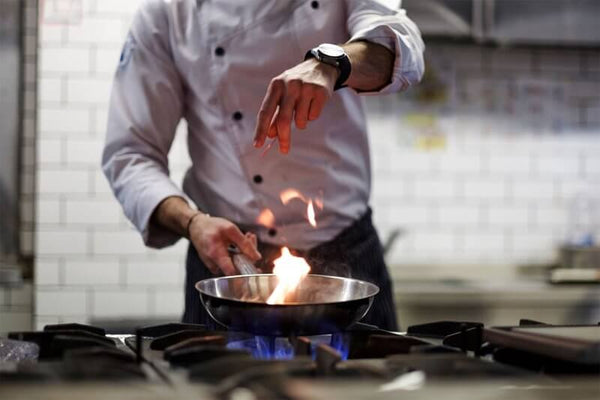Having the right professional cookware is essential in any commercial kitchen. When foods stick to the surface of pots and pans, it can not only become a nightmare to clean, but can be a nightmare to serve. In a commercial kitchen especially, cookware sees its fair share of use, which makes it even more important to have high quality tools on your side. Many chefs often rely on the help of aluminum, stainless steel, and nonstick cookware. But, are they the same? In this article, we are going to outline the difference between stainless steel, aluminum, and nonstick cookware so you can stock your kitchen with the best tools for your specific cooking needs.
What is Aluminum cookware?
The most common pot or pan in the
commercial kitchen is aluminum. They are light, excellent conductors of heat and are inexpensive compared to Stainless steel pots and pans.
Major drawbacks to aluminum
- Aluminum lacks the amount of nickel required to activate an induction burner.
- Pots and pans made of aluminum or untreated cast iron can leech metal flavor into high acid foods like tomato sauce.
- Aluminum pots should be avoided when performing reduction whisking of dairy to make an ice cream or soufflé base. The heavy whisking action will leach metal taste into the food.
What is Stainless Steel Cookware?
When you are looking to buy stainless steel cookware, there are a few things you’ll need to know. First, take into account the metal, the weight, and the price. Then, dive a little deeper by looking at the following. Stainless steel cookware is usually made from a combination of metals, such as iron, carbon, and chromium. They can also have small traces of copper, which is another very popular cooking material. But, the outermost layer should be stainless steel. The heavier, the better. Because this style of cookware is made from metal, it should have a decent weight to it. Weight can confirm that the stainless steel cookware is in fact stainless steel cookware. The weight can help prevent hot spots to ensure seamless cooking from corner to corner.
Why Commercial Chefs Should Use Aluminum and Stainless Steel?
Stainless steel is one of the
most durable forms of cookware on the market. It can handle high heat, temperature, and vigorous use while producing even heating for long periods of time. Aluminum or stainless steel
fry pans are meant for browning meats. Because the cookware can handle high temperatures, it creates the perfect surface to brown, crisp, or sear meat without any problems. Aluminum and stainless steel
sauce pots, stock pots, braziers, and dutch ovens are also great for boiling. The metals can hold on to heat for longer, creating the perfect hot spot for soups, stews, and other boiled foods. The main difference is that aluminum will have an even heat surface while the Stainless will have hot spots at the direct flame contact sites. Because this style of cookware does so well with heat, it is actually not great for delicate foods. If you do a lot of sautéing or handling gentle heating,
stainless steel cookware might not be the best choice. The surface is not layered with nonstick properties, which can cause food to cling to the surface, making cleanup and cooking a bit challenging. But, for those foods that need solid browning or crisping, stainless steel cookware can greatly improve the final results.
What is Nonstick Cookware?
During your research or time as a commercial chef, you have probably heard of something called polytetrafluoroethylene. This is a chemical compound that is used to coat the inside of nonstick cookware to make foods easily slide across the surface. For decades, this chemical compound has been the leading material used to make nonstick cookware, but today, there have been some advancements to make this style of cookware better and last longer. With the addition of ceramics, enameled cast iron, and even silicone, nonstick cookware has become something that commercial chefs absolutely need in the kitchen. At their core, nonstick cookware is cookware infused or lined with a coating that does not allow food to stick to it. High heat cooking is not recommended with non-stick coated pans because the high heat will cause the coating to detach and may get into the food or ruin the pan.
Why Commercial Chefs Should Use Nonstick Cookware?
Nonstick cookware can provide
kitchens of all sizes with many benefits. Because food doesn't stick to the surface, it makes for quick and easy clean up. In some cases, chefs really only need to wipe the surface down with a paper towel between uses. This can save the cooking staff a lot of time and energy in the long run. Eggs love to be cooked on a non-stick surface. This also is a great way to create healthier foods. Unlike stainless steel, with nonstick cookware, you do not need to use oil to keep the food off the pan. In some cases, you don’t need to use oil at all.
Which Cookware is Best for Your Kitchen?
In any kitchen, no matter the size, it is healthy to have a balance of aluminum, stainless steel and nonstick cookware. While stainless steel cookware can be seen as more of a specialty style of cookware for some kitchens, it can drastically change the outcome of meats and other browned foods. For daily, simple foods, nonstick cookware can be a great option to provide quick cooking and quick cleaning. Having a balance will ensure that your kitchen is well rounded and that it can accomplish any cooking style with safety and ease. Start
building a better kitchen with aluminum, stainless and nonstick cookware from Chefs’ Toys.























